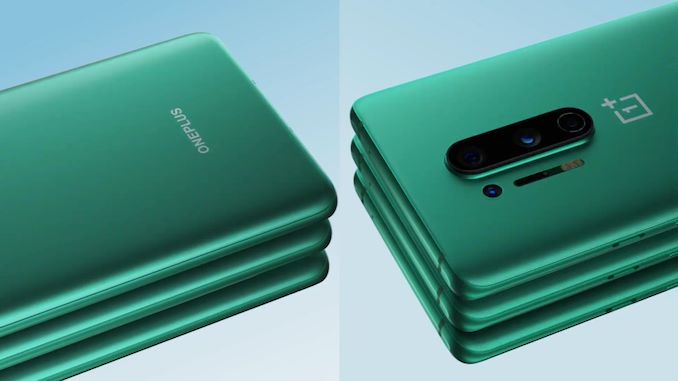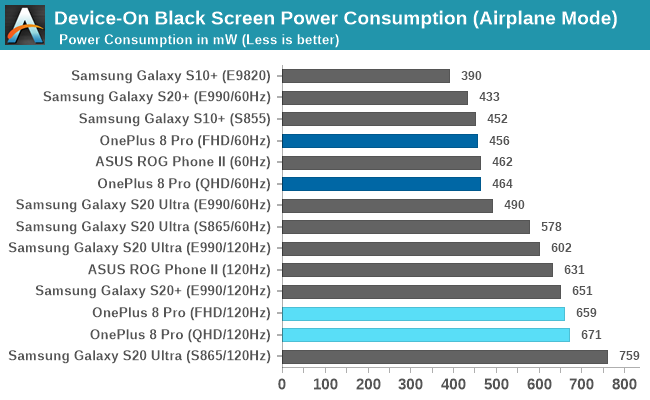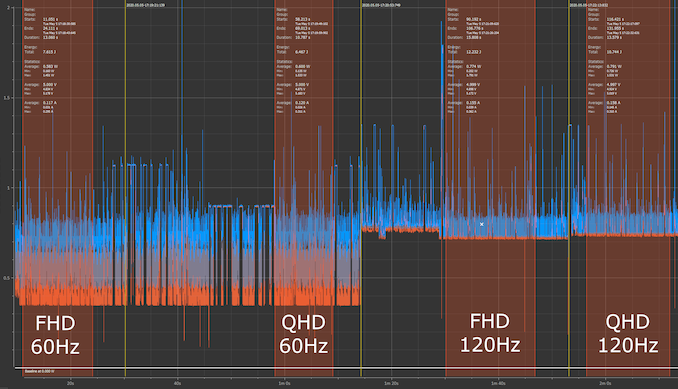120Hz On The OnePlus 8 Pro: QHD+ Resolution But Still Power Hungry
by Andrei Frumusanu on May 5, 2020 1:00 PM EST- Posted in
- Mobile
- Smartphones
- OnePlus
- OnePlus 8 Pro

High refresh rate displays in smartphones are all the rage in 2020, but the new exciting feature is still in its infancy in terms of hardware implementations. Currently there’s still a lot of caveats when using the higher refresh rate, particularly a large impact on the battery life of the phone.
A few weeks ago we covered the characteristic in Samsung’s Galaxy S20 series, noting how it results in a quite large bump in the power consumption of the device, even when seemingly not actually displaying any dynamic content on-screen.
The new OnePlus 8 Pro is another 120Hz flagship device that’s been recently released, and we finally managed to get our hands on a sample. Curiosity got the best of me and the power consumption of the phone at different refresh rates was amongst the first things I tested, particularly because the phone offers the 120Hz refresh rate at a native QHD+ software rendering resolution – something Samsung’s Galaxy S20 series can’t do.
Observing the input power of the phone for a more graphical representation of the different modes, we immediately see that OnePlus’ 120Hz mode incurs a similar power jump to that of the Galaxy S20. The figures here aren’t quite correct as the phone’s power usage when connected to USB is unusually high so don’t pay too much attention to those numbers – just at the differences between the modes.
We can also see that there’s extremely little difference in the base power consumption of the phone between the FHD and QHD modes, both at 60Hz and 120Hz refresh rates. This is actually an important indicator as to narrow down whether the power draw comes from the SoC, or the display panel or DDICs.

Re-measuring the power in a more correct manner, the OnePlus 8 Pro falls in line with other phones of this generation, both at 60 and 120Hz.
We had expected the OnePlus 8 Pro to fare off worse than the Galaxy S20 series, and yes it does draw slightly more power – but not as much as I had initially thought it would. The hardware differences between the phones here relates to their display interfaces, the Galaxy S20 series features a single MIPI lane to the DDIC, a bottleneck that is the reason for why the phone can’t do QHD at 120Hz. The OnePlus 8 Pro on the other hand does feature dual MIPI interfaces to the display panel and thus has the bandwidth necessary for driving the higher refresh rate at the highest resolution.
The fact that the differences between the two phones is only a mere 20-25mW means that the display interfaces have very little to do with the increased power draw. The difference in the base power consumption between FHD and QHD modes is a mere 10mW, so seemingly that also has very little impact on power other than the additional power to actually render higher resolution dynamic content.
It seems that the power consumption here solely is to blame on the DDIC and the display panel itself, both having to work harder to drive the pixel matrix at higher frequencies. It’s a somewhat discouraging confirmation as it means the ecosystem is in dire need for true VRR (variable refresh rate), where the panel doesn’t need to be driven like this during static content.
We’ll be reviewing the OnePlus 8 Pro in more details in a full review in the coming weeks – today’s quick pipeline was just meant to address this burning matter of the 120Hz implementation of the phone. Generally, I expect the 120Hz mode here to have a slightly higher battery impact than what we saw on the S20 series, but nothing to drastically worse.











27 Comments
View All Comments
atkoj - Tuesday, May 5, 2020 - link
And that right there is a great example of why I still come to Anandtecheastcoast_pete - Tuesday, May 5, 2020 - link
Agree. Thanks Andrei, that adds some key information on what is eating battery with high Hz screen refreshing.PeachNCream - Tuesday, May 5, 2020 - link
So the bottom line is that higher refresh rates result in smoother UI but shorter battery life as opposed to a resolution bump or some other factor being responsible. Interesting and good reasoning for hanging around at 60Hz if you aren't too worried about the limited benefit of driving refresh to twice the rate.DabuXian - Tuesday, May 5, 2020 - link
That's a nice observation, especially interesting to see how FHD and QHD makes barely any difference, I had no idea. Can't wait to read the full review.Cliff34 - Tuesday, May 5, 2020 - link
For most things, fhd and qhd don't make a diff. I do notice 4k videos are noticeably sharper.OddFriendship8989 - Monday, May 11, 2020 - link
Yes but the test here is a black screen, so of course there shouldn't be a difference between FHD and QHD. In fact, ideally you would see no difference across all 4 combinations (QHD/FHD/60Hz/120Hz)Jedi2155 - Wednesday, May 13, 2020 - link
I'd argue otherwise. If you look on the time/energy graph it tells a different story than the steady state power consumption which was minimal.If you look at both the FHD vs. QHD results you'd see FHD uses between 13-20% more energy than the QHD test. I suspect this is related extra processing resources to DOWNSAMPLE the image resulting in more energy consumption.
Between FHD and QHD 60 Hz (17.75% more)
7.615/6.467
1.1775x
Between FHD and QHD 120 Hz (13.84%)
12.232/10.744
1.1384x
hd-2 - Tuesday, May 5, 2020 - link
I'm curious to see the impact of the variable refresh rate Razer uses on their phones with 120Hz displays.Andrei Frumusanu - Tuesday, May 5, 2020 - link
They don't have VRR, they just have refresh rate switching.hd-2 - Tuesday, May 5, 2020 - link
Don't mean to confuse with the terminology, just going based on their FAQ/support page that states "The Razer Phone’s UltraMotion™ display not only offers a 120 Hz refresh rate, it also features variable refresh rate" - Regardless of the language, I'm more curious regarding the functionality. Based on the difference between 60Hz and 120Hz in the chart above, I'd guess it would go down to some constant low draw, just curious what that would be (although I'd also venture to guess that more OEMs would implement some sort of dynamic refresh rate based on content if it really saved that much power).